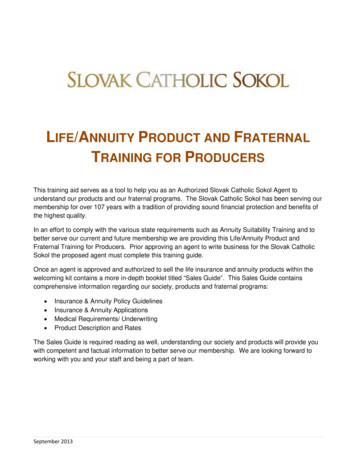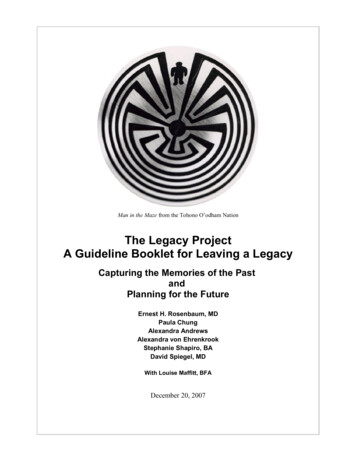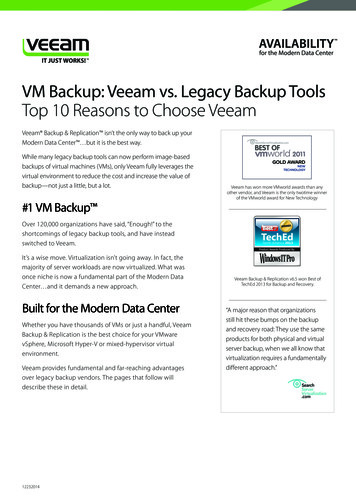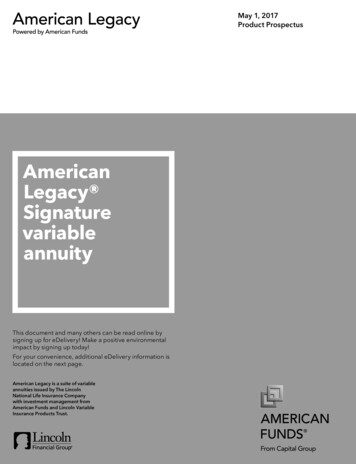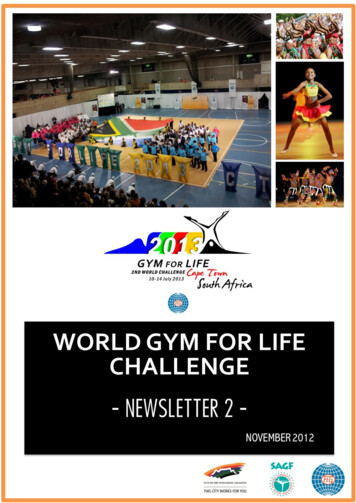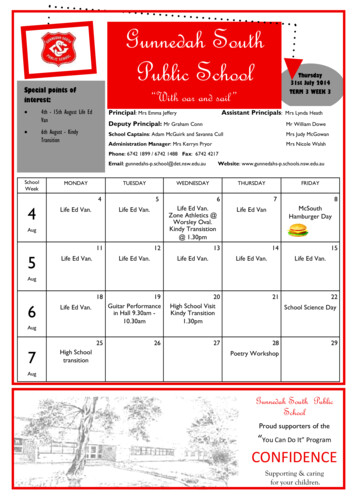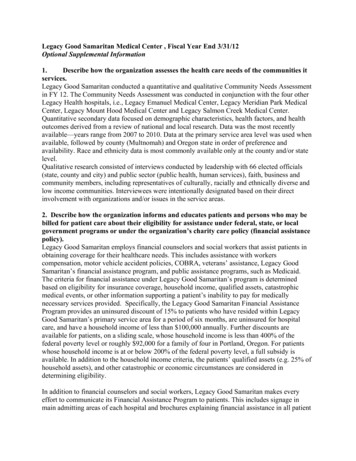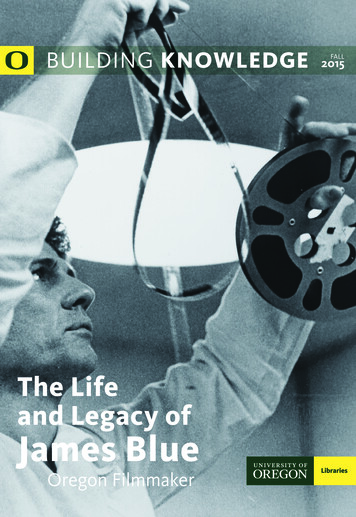
Transcription
BUILDING KNOWLEDGEThe Lifeand Legacy ofJames BlueOregon FilmmakerFALL2015
LOOKING FORWARD,STRATEGICALLYCO N T E N T SFrom the Dean: Looking Forward, Strategically. . . . . . . . . . . . . . . . . . . . . . . . . . . . . . . 1Prologue. . . . . . . . . . . . . . . . . . . . . . . . . . . . . . . . . . . . . . . . . . . . . . . . . . . . . . . . . . . . . . . . . . 2Oregon History, Family, Libraries: 1 Million Gift Endows SCUA Director. . . . . . . 4Genius in the Making: Looking ahead to The MakerSpace. . . . . . . . . . . . . . . . . . . . 10Flight Club Oregon is Ready for Takeoff. . . . . . . . . . . . . . . . . . . . . . . . . . . . . . . . . . . . 14The 2014 Undergraduate Research Awards. . . . . . . . . . . . . . . . . . . . . . . . . . . . . . . . . 16Rhapsody in Blue: The Legacy of Award-Winning Filmmaker James Blue ’53. . . . . . . 20Building the UO Athletics Images Collection with Paul W. Harvey IV. . . . . . . . . . 26Checkmate! Or, Who Was “No Telephone” Smythe?. . . . . . . . . . . . . . . . . . . . . . . . . . 31From the Development Director / By the Numbers. . . . . . . . . . . . . . . . . . . . . . . . . . 32FALL IS AN exciting time for us in theUniversity of Oregon Libraries, especially as wewelcome new and returning students and facultyinto our community. We’re carrying out anambitious new strategic plan, with majorinitiatives in place to expand our digital libraryservices, our research data managementprogram, and our library teaching efforts.Construction on our new Allan Price Science Commons and Research Library is ongoing, withimpressive results. Other recent projects include wayfinding signage improvements in the KnightLibrary, an extensive suite of online research guides developed by our subject specialist librarians,and new service points for math and writing tutoring in partnership with UO’s Teaching and LearningCenter. Participation in library events and activities is strong. Evidence abounds that many UO studentsand faculty are thriving in their academic endeavors, and that they view the library as a valuablepartner and center of support.As we look to the future and consider the ways we can build upon these successes, we’re embracing acollective vision where the Libraries serve as a powerful catalyst for learning and knowledge creation.We want to continuously innovate, adapt, and excel in our efforts to improve the world throughexemplary library service. In order to realize this vision, we’re reaffirming our values, which includeuser-centered and evidence-based approaches, creativity, responsiveness, teamwork, and integrity.We’re committing ourselves to five major goals:HIGH-QUALITY COLLECTIONS AND CONTENT » to stimulate the university’s teaching, learning,and research through the collaborative provision of high-quality content and collections.EXEMPLARY TEACHING, RESEARCH, AND ENGAGEMENT » to work together with diverse partnersto fuel discovery, create new knowledge, and enrich people’s lives.OUTSTANDING LEARNING ENVIRONMENTS » to create outstanding virtual and physical learningenvironments for UO students and faculty.USER-FOCUSED CULTURE » to foster a creative, innovative, and user-centered culture throughoutthe Libraries.IMPROVED INFRASTRUCTURE » to strengthen the Libraries’ ability to sustain and support essentialprograms and resources for the university.We can accomplish these major goals only with the deep collaboration and support of our friends anddonors. We deeply appreciate our community’s support, because we know that it leads directly toimproved library services and programs for UO students, faculty, and the community.On behalf of the UO Libraries, thank you sincerely. Please contact me if you have any questions orwould like to learn more about our plans for this academic year.Adriene LimDean of Libraries and Philip H. Knight ChairUNIVERSITY OF OREGON LIBRARIES 1
PROLOGUEFacts forPutting outFiresGET A ROOM!Our New Reservation SystemASK TODAY’S students what comes to mind first when they thinkof the library, and the answer may surprise you. Some might say“books” and some might say “tech”—and some might even say“librarians”—but the most common answer may well be “studyspaces.”From quiet, out-of-the-way reading nooks to group conferencerooms hardwired with the latest technology, today’s studentscome to the library in search of the perfect space. Space to study,space to spread out and collaborate on group assignments—evena comfortable space to catch a quick nap.Now it’s easier than ever for students to connect with libraryspaces thanks to our new, automated room reservation system.Accessible from laptops and smartphones via the UO LibrariesEVERY YEAR, the library provides on-callendowment funding for student employeetrainings, special projects, and initiatives.website, the LibCal platform allows students on or off campus tocheck up on the many study spaces we offer. They can book andconfirm room reservations almost instantly, automate reservationcalendaring, and access policies and guidelines—all up to fourweeks in advance.The State of BlackOregon ReportON MAY 28, the the Urban League of Portland (ULPDX) came toKnight Library to share and discuss findings of their 2015 State ofBlack Oregon Report with UO and the Eugene community.Coordinated by Government Information Librarian Jonathan Cain,the event was co-sponsored by UO Libraries and the Departmentof Planning, Public Policy and Management.DIGITALREDECORATING:Fresh Wallpaper“Our goal is to create professional developmentopportunities to enhance the skills and talentsof the UO Libraries’ student workers,” saysResource Sharing Operations Specialist KateBall, chair of the Student Development FundGroup. “In the 2014-15 academic year, weoffered workshops on everything frombookbinding to CPR to handling hostilevisitors.”On April 29, Knight Library hosted thehottest learning opportunity of all,a special training session presented bythe Eugene Fire Department. Studentsand library staff received instructionin best use of a vital safety tool thatsometimes gets taken for granted,just because it is so familiar: the fireextinguisher. At the library, we’re alwayson guard against burning books!Rolling out Canvas with CMETDID YOU KNOW the librarysponsors an annual digitalwallpaper design competition,open to all UO students? AliGarrett, a senior majoring indigital arts, created this year’swinning design. Her colorfulabstract soon will be familiar toeveryone on campus—they’llsee it displayed on the library’s700 computer workstationsand internet kiosks throughoutthe 2015-16 academic year. Thewinner also received a 250prize. Congratulations, Ali!EVERYBODY KNOWS the truth about moving: the build-up is exciting, itfeels great when you finally arrive . . . but it can be a big pain the wholetime you’re getting there. Now imagine moving all the digitized contentfor tens of thousands of college courses from one learning platform toanother. Not just that—also getting hundreds of college instructors upto speed on how things work with the powerful new software.Over the past year, our Center for Media and Educational Technologies(CMET) has been meeting this monumental “moving” challenge. As thenew fall term begins, we are pleased to announce that the migration isan unqualified success! All credit courses taught in prior terms at theUniversity of Oregon have been switched to Canvas. That’s 25,807courses in all! And our faculty are creating and publishing new courses in Canvas every week.Canvas: a clean slate for improved learning outcomes. Brought to you by the hardworking people atCMET. (Just imagine how much coffee they drank!)More Tribal Papers Added to Historic Oregon NewspapersULPDX President & CEO Nkenge Harmon Johnson presentedresults of a two-year program of research, providing an updatedlook at how Black Oregonians are doing in both urban and ruralcommunities statewide. The 200-page report features 18 essayson issues including education and childcare, gentrification, andentrepreneurship. It also puts forth a bold policy agenda includinga comprehensive jobs plan for Black Oregon and a proposal toimprove health outcomes for Black mothers and children.To learn more about the State of Black Oregon 2015, go toulpdx.org.2 UNIVERSITY OF OREGON LIBRARIESTHANKS TO collaborations with the Confederated Tribes ofGrand Ronde and the Confederated Tribes of Warm Springs—plus funding from UO Libraries donors Carol James, and Andreaand Dave Arlington—four new titles documenting NativeAmerican news, views, and history are now available forsearching and browsing on Historic Oregon Newspapers online,a project of the library’s Oregon Digital Newspaper Program(ODNP).The Weekly Chemawa American and The Chemawa Americanwere published by students of the Chemawa Indian BoardingSchool just north of Salem, issues dating from 1901-1915. We also have1978-2013 issues of Smoke Signals, the current newspaper of theConfederated Tribes of Grand Ronde, and 1985-2005 issues of SpilyayTymoo, the current newspaper of the Confederated Tribes of Warm Springs.“In 2015 these new titles joined the Klamath Tribune (1956-1961)—digitizedin partnership with the Klamath Tribes and available online since May2014—as important representatives of Tribal publications and perspectives,”says Sheila Rabun, interim director of the UO Libraries’ Digital ScholarshipCenter. “Our goal is to make the collection inclusive of the many diversevoices contributing to Oregon’s history.”From Smoke Signals (Grand Ronde, OR), December 1, 2002.
OREGONHistory, Family, Libraries 1 Million gift from Giustina siblings will secureoutstanding SCUA leader and enhance vitallibrary resourcesBy Jason StoneT H E AU TO G R A P H S O F every U.S. Presidentfrom Washington to Reagan. Oregon Trail diarieshandwritten by pioneer women. Glass-platenegatives of historic Native American portraits.The original drafts of Abigail Scott Duniway’ssuffragist speeches. Bill Bowerman’s lettermansweater and the game ball from the 1920 Rose Bowl.The manuscript of One Flew Over the Cuckoo’sNest, straight from Ken Kesey’s typewriter. A folioof Shakespeare’s plays published in 1632. Alimited-edition artist’s book printed and boundonly months ago.What do these things have in common? They allshare the same home.Featuring one-of-a-kind documents, rare volumes,original works of art, and more than a millionphotographs, the University of Oregon’s SpecialCollections and University Archives (SCUA)constitute an unparalleled record of PacificNorthwest history and culture—one of thelargest such collections in our region.4 UNIVERSITY OF OREGON LIBRARIES“People sometimes ask me about the monetaryvalue of our special collections and archives,”says Adriene Lim, Dean of Libraries and Philip H.Knight Chair. “I tell them, in terms of its value asan intellectual resource, there’s no exaggeration insaying it is priceless.”A resource this valuable demands the very best:the best in collections development, the best inarchiving, the best in stewardship, and the best inpublic service. In the UO Libraries’ SCUA, our staffof nearly a dozen professionals plus many studentassistants work every day to assure that we meetand exceed these high standards. Now, thanks toa generous donation, first-rate leadership andinnovation for this crucial area of the library’smission have been assured.In August 2015, the library celebrated a 1 milliongift from the Giustina Forest Foundation, comprisedof Dan, Gennifer, Nick, Tom, and Greg Giustina—five siblings with Eugene roots and longstandingties to the UO.“The Foundation has endowed the GiustinaDirector of Special Collections and UniversityArchives, and we are truly grateful for thismilestone gift,” said Dean Lim. “In the upcomingmonths and for perpetuity, this endowmentensures that we will always be able to recruit andretain the strongest possible candidate to serve inthis vital leadership role.”T H E S E DAYS, Dan, Gennifer, Nick, Tom, andGreg live in different cities, different time zones,even different continents. But make no mistake—the Giustinas are a Eugene family through andthrough. Their parents, Ehrman and Lee, wereboth UO graduates, and the siblings grew up in aneighborhood not far from the heart of campus.Their memories of childhood take place in an erawhen Eugene was smaller in size and more leisurelyin its pace. A time when town-and-gown relationswere more casually woven into the everydaypatterns of local life.“This endowment provides security,prestige, and resources that will help usto attract and keep the very best leader tocare for our precious library resources.”—UO PRESIDENT MICHAEL SCHILL“I still like to think of it as it was then: the smallcollege town that I grew up in,” says Nick Giustina(’72, MA ’81). “Walking home from grade school,I would pass along the edge of campus every day.“Back then, the UO ran summer athletic programsfor neighborhood children. We would be droppedoff, divided by age, and put through what seemedhours of systematic activity at the physical ed.department: all the field sports, court sports, track,swimming, and I especially recall the gymnasticroutines. This was pretty normal stuff for Eugeneand the late ’50s, early ’60s. But for kids so youngliving in a lot of other places, I don’t imagineUNIVERSITY OF OREGON LIBRARIES 5
“Empirical experience is important inlearning. You might “know” the differencebetween vellum and parchment, but thedistinction becomes so much clearer ifyou can actually see and touch them.Those are the kinds of opportunities thatSCUA provides for students.”—NICK GIUSTINA ’72, MA ’81there’d have been a chance to ever see a pommelhorse, let alone get qualified instruction on its use.”Nick and his brother Dan Giustina (’72, MBA ’74)also credit the UO with providing their first realwork experience. Dan, age 15, worked as adishwasher in Bean Hall. Nick cleaned dormrooms and washed windows.“Even in the very early ’60s, I don’t quite recall howkids of our age were assigned to this work,” Nickreflects. “I’m sure an age limit would apply now! Butin those days, doing this job was perfectly natural.”As the Giustina kids grew older, they all wereexpected to keep busy working. Their father insistedon it. They did every kind of job from retail clerkingto pulling lumber on the green chain. “To this day, theheat doesn’t bother us in the least,” Nick commentswhile strolling across the Memorial Quadrangle onan unusually sizzling June afternoon. “Not afterspending so many summers on the green chain.”As they step into the soothing shade of KnightLibrary, Dan Giustina, a former trustee and pastpresident of the UO Foundation, concurs about theedifying value of hard work. He also credits anotherdiscipline that was instilled by their parents:reading. “Our mother and father were both readers,”he says. “When they weren’t working, they read forpleasure. And they passed on that habit of readingto all their children.”“Recreational reading is sort of a family idiom,”Nick explains.Fitting then, that the Giustina siblings would comeof age in the era when Lane County, Oregon’sbrightest literary star was in full ascent.“Ken Kesey became popular about the time we weregrowing up,” Dan reflects. “Reading his work—especially Sometimes a Great Notion, because it’sabout the timber industry in Oregon—there was animmediate sense of connection. He was writingbooks that weren’t just popular; they would go onto become a part of our literary heritage.”At pains to stress that he was never a fellow traveleror confidant of Kesey’s—“I wasn’t one of those whowere literally on the bus”—Nick effortlessly calls tomind the galvanizing atmosphere of that time, inthis place. Those were eventful years indeed for aUO undergrad. Along with the excitement ofdiscovering works on modern poetry in the cardcatalog, he remembers ducking inside the libraryto avoid teargas and trashcan fires on 13th andKincaid. He also recollects sighting the outrageousfigure of Ken Kesey around Eugene and Springfieldon a number of occasions. Or did he? As Nickexplains it, the memories of locals can get kindof tricky where Kesey’s concerned.Even so: that guy he spotted on Lincoln Street oneway-back winter’s day—the one driving through adownpour with a big smile on his face and the topdown on his convertible?Sometimes a Great Notion,page one: Ken Kesey’s longhandfirst draft and original typewrittenmanuscript.“Pretty sure that had to be Kesey,” Nick declares,sharing a smile of his own.F L A S H F O RWA R D BY decades. Same place,different era. The ‘Kesey Connection’ reasserts itself.“Nick and I first got to know the UO Librariesthrough our interest in the Ken Kesey Collection,”Dan explains.Beginning in the late ’60s, Kesey periodically broughthis papers to the UO, depositing them with thelibrary for safekeeping. After his death in 2001, hiswidow Faye added about 30 more boxes of material.Given the author’s longstanding ties to his almamater, this was a natural arrangement—but, as timepassed, all parties agreed it was an arrangement thatneeded to be formalized. In 2011, the libraryannounced our goal of raising 1.4 million topurchase the collection and give it a permanenthome. Donations large and small poured in, butafter nearly two years of energetic and creativefundraising, we were still coming up short. Unlessthe gap could be closed soon, there was real dangerthat Kesey’s papers might be purchased by an outof-state institution.“Everybody’s afraid that something might happen,and something might.” In 1967, Ken Kesey gave acampus talk on ‘Mom, Dad, and Dope.’“The memories of locals can get kind oftricky where Ken Kesey’s concerned.”—NICK GIUSTINA ’72, MA ’81“My brothers and sister and I all were veryenthusiastic to retain those materials,” says Dan.“We felt that collection really belongs here at theUniversity of Oregon, no question.”6 UNIVERSITY OF OREGON LIBRARIESIn order to ensure that Kesey’s papers would neverend up in Texas, California, or points even fartherafield, the Giustina siblings—as individuals,already longstanding supporters of variousuniversity initiatives and projects—stepped forwardin February 2014 to offer their first-ever collectivegift. It was likewise their first gift to the Libraries.Colorful panels from the author’s 1968 Jail Journal are a popular part ofthe Kesey Collection.
It was more than just idle talk. Dan, Gennifer, Nick,Tom, and Greg again came together to pledge anadditional 1 million, endowing a new leadershipposition at the UO Libraries: the Giustina Directorof Special Collections and University Archives.In the Ken Kesey Classroom, L-R: UO student Jeffrey Newmark, Nick Giustina, arts and administration instructor David Turner,student Indigo Vance Eyebright, Dan Giustina, student Esther Weng, Dean of Libraries and Philip H. Knight Chair Adriene Lim“We’ve always done things as a family.We feel that together we can do morethan one person can do.”—DAN GIUSTINA ’72, MA ’74By providing 1 million to cover the remainingcosts of securing the collection, they ensured that itwould forever remain with the state, the county,and the school that Kesey loved most.Invited to name a library space in recognition oftheir generosity, the Giustinas elected to furtherenshrine the author’s legacy by designating the KenKesey Classroom in Special Collections andUniversity Archives.“We’ve been grateful for the opportunity to attachour family name to some other excellent resourceson this campus,” Nick reflects. “In this case, webelieved it was far more appropriate to honor KenKesey than to put our own name on it.”SCUA is a major resource for academic researchers.8 UNIVERSITY OF OREGON LIBRARIESHaving contributed so much based largely upontheir estimation of the author, the Giustinas werecurious to learn more about the collection and theplace where it would permanently reside. So theystarted getting to know SCUA better. And theirengagement soon grew beyond Kesey. A key part ofany research library’s holdings, special collectionsand archives are at once a storehouse of knowledgeabout the past and the raw materials for futurescholarship. To aficionados of literature and history,they’re a genuine treasure trove.Dan Giustina says that he and his siblings were“astounded” when they began to learn about thedepth and breadth of the UO Libraries’ archives.They were also quick to recognize the need forexceptional SCUA leadership. “For the library aswell as the entire university, we can accept nothingless than the best of the best,” Dan, spokesman forthe group, asserted. “Our goal should be to recruit ascholar and leader of the highest caliber.”. and also open to the public.In thanking the Giustinas for their gift, Dean Limwas thrilled to note that the 1 million endowmentis not only exceptionally generous, but highlyrelevant to the library’s mission. “Among otherimportant duties, the director of SCUA is ultimatelyresponsible for overseeing the permanent preservationof unique, often priceless materials,” she said. “Theperson who fills this role will also facilitate publicaccess to these collections and, in that way, is avaluable partner of our high-achieving facultymembers and students.”A LOT H A S changed in Eugene (never mind theworld) since the 1950s and ’60s. For many of us,library books remain a cherished constant in timesof constant change. These days, the Giustinas alllike to read different things. From the common rootsof childhood, their paths have led them to diverseinterests, different careers and lifeways. Every bigchoice in life seems to inspire its own reading list.Plenty of the little ones do, too.After viewing these artifacts of history, Dan reflected abit on his own family’s past. “I think our enthusiasmfor the library and for higher education in generalgoes back to our parents,” he said. “We were taughtas children that education is a gift. My father alwaystold us, ‘Your education is the one thing that nobodycan ever take away from you.’ Part of our duty as wego through life is to help give others the sameopportunities.”Nick spoke of the library’s—and particularly thearchives’—value to students. “The library is the truecenter of the university; the place where learning isamplified. And for many learners, SCUA is thewindow into the library. These collections can act asdirect inspiration for the achievement of students.“By promoting individual students’ engagementand success, we can ultimately provide the greatestgood for the greatest number. And really, isn’t thatwhat it’s supposed to be all about?”Located on the second floor of Knight Library, the Special Collectionsand University Archives are open to the community at regularhours during the school year and between terms. Learn more atlibrary.uoregon.edu/special-collections.“I hardly ever pass by a bookstore withoutstopping,” Nick says. “I’ve the same affinity forlibraries. My academic, college teaching, andrecreational work is usually done in a library. MyPortland home is two blocks from a county librarybranch: it’s closer than Starbucks and more useful.”On a recent visit to the UO Libraries, Nick and DanGiustina were treated to an impromptu exhibit ofhighlights from our special collections and archives,assembled for the occasion by SCUA staff. Dan, alongstanding Ducks fan and supporter, admired thewealth of archived material relating to athleticshistory and campus life. Nick, a longtime educatorwhose personal tastes run more to Shakespeare thanSuperman, still expressed delight in learning thatthe collections include major holdings of historiccomic books. Together, the brothers marveled atoriginal photogravure Edward Curtis prints and theexquisitely detailed calligraphy of medievalmanuscripts.UNIVERSITY OF OREGON LIBRARIES 9
GENIUS intheMAKINGLooking ahead to The MakerSpace,a crucible for innovation in the Allan PriceScience Commons and Research LibraryBy Jason Stonemak·er \'m -k r\n.1. One that makes ormanufactures.2. One who engages increative do-it-yourselfprojects, especially thoseA WARNING TO the uninitiated: this story involvesdrones, lasers, sumo robots, 3D imaging, miniaturesatellites, and a crack team of scientists whorendezvous deep in the desert to launch experimentalrockets. Is it a comic book? Science fiction? The latesttechno-espionage thriller? Hardly. All of this is true,and it’s happening in the here and now.The future, it would seem, has arrived. It always does.Inevitably. Yet it never loses the power to amaze.“At first, there’s always that ‘new’ factor,” says Scienceand Technology Outreach Librarian Dean Walton.“People first hear about a new technology—3Dprinting, for example—and their reaction is, ‘Really?involving technology. UNIVERSITY OF OREGON LIBRARIEShis natural curiosity a powerful new focus. He soongot interested in ham radio and that led to a twentyyear hobby. And another hobby building modelrockets. And another tracking flight transponders inair crash simulations. Eventually, it all led to a PhD inPharmacology from Georgetown. Followed by a careeras a field biologist. Followed by a second career as ascience librarian. He joined the UO Libraries in 2005.To meet this demand for hands-on access to the latestand best technology tools, Walton is championing oneof the special resources planned for the University ofOregon’s new Allan Price Science Commons andResearch Library. Envisioned as a “dream-it, do-it”center for experimentation and production, TheMakerSpace will be equipped with 3D printers andscanners, a laser cutter, electronics soldering station,industrial sewing machine, drill press, vinyl cutter, andmore. Picture a combined science lab, craft studio,garage workshop, and high-tech toy box for creativelyinclined grownups, and you won’t be too far off.“About that time I also got involved with some folkswho were doing sumo robotics,” Walton remembers.“We built and programmed little robots; they would beplaced inside a meter-wide circle and compete to seewhich could push the other out first. You programmedattack behaviors, evasive behaviors—basically, it was afriendly contest to outfox the other programmer.Dean Walton, Scienceand TechnologyOutreach Librarian“Several years later, that group merged with othersinto a more broadly focused maker group. Now we hadpeople with diverse skills and interests collaboratingon different projects.”Margaret Bean, head of the Science Library, notes:“There are other UO departments that have some ofthese same tools, but they’re scattered all over campusand access is often limited to people who are enrolledin certain advanced classes. Ours will be open toeverybody.”Everybody meaning everybody. The MakerSpace will bea library resource, so it will be here for the entire UOcommunity—proof that the Science Library is a placeto be for more than just science majors.“Whoever you are,” Walton vows, “the idea is to lowerbarriers of entry and set more people free to experiment.”WHEN DEAN WALTON WAS GROWING UP, he andhis sister helped their father assemble a Heathkit TV—the family’s first color set. The project took twoyears to complete. Then, the moment of truth: allgathered around as the homemade set was pluggedin and switched on for the first time . . .And it worked great!(from The American Heritage Dictionary of the English Language,Fifth Edition 2015 by Houghton Mifflin Harcourt Publishing Company.)10How? I’ve got to see that for myself!’ And it is a cooltechnology, but there’s nothing that’s really magicalabout 3D printing. Once you see it and have a conceptof how it’s done, it’s like: ‘Oh, of course! Why didn’t Ithink of that?’ So I believe the novelty has peaked. Butnow people have seen the power of it, and it’s shiftedto a different kind of excitement: they’re excited to getin there and use it themselves.”This was a formative experience for Dean. Already aboy who liked the feel of tools and the excitement ofexploring the world around him, building the TV gaveHe began brainstorming ways to bring the same hands-on,experimental, and fun methods of learning-by-doinginto the classroom. Things really took off when theScience Library acquired its first 3D printer in 2013.After brushing up on the operation of the printer,Walton secured a grant from UO STEM CORE anddeveloped a program for 4th-8th grade sciencestudents to design, fabricate, and test their own rocketnose cones. The kids took to the assignment with evenmore enthusiasm than he’d hoped for. They wereexcited that they got to make something and see theirideas come to life. Even more impressive were theresults. Many of the kids produced surprisinglyUNIVERSITY OF OREGON LIBRARIES 11
Today makerspaces are more common in Europe thanthe USA; Germany alone has more than 100. They’realso a key part of the educational and entrepreneurialinfrastructure of many developing nations. Stateside,the 2014 Maker Faire in San Mateo, California drewmore than 120,000 participants. Make magazine hasbeen published since 2005, and the first maker filmfestival was held last year.Rocket nose cones designed and tested by grade school students in DeanWalton’s summer science workshop.aerodynamic cones of the usual type; othersdemonstrated an innovative spirit with adventurous,experimental shapes and designs.Later, Walton adapted the same lesson for a professionalworkshop with teachers. To his surprise, all the cohort,without exception, designed the familiar-shaped nosecones. Good, effective nose cones all—but more orless all the same. Walton began to ponder ways thathe, a librarian, might go about helping adult learnersto unlock the sense of creative experimentation thatthe youngsters had enjoyed.The mainstream press is also taking notice. Iconicbusinesswoman Martha Stewart wrote recently: “Themaker spirit is vital to our economy.” Likewise, Timemagazine technology columnist Tim Bajarin observes:“As someone who has seen firsthand what can happenif the right tools, inspiration and opportunity areavailable to people . . . it would not surprise me if thenext major inventor or tech leader
Klamath Tribune (1956-1961)—digitized in partnership with the Klamath Tribes and available online since May Center. "Our goal is to make the collection inclusive of the many diverse voices contributing to Oregon's history." DIGITAL . REDECORATING: Fresh Wallpaper. bookbinding to CPR to handling hostile visitors."


